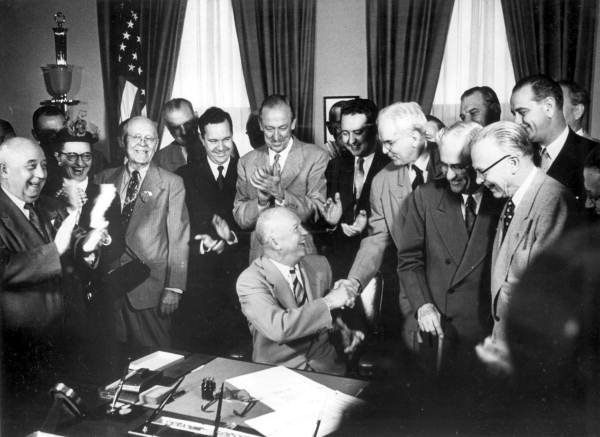[ad_1]

The postwar period was a time outlined by unparalleled prosperity. Subsequent the 2nd World War, returning GI’s arrived property to a booming economic system, housing growth jobs, and support plans like the GI Invoice that expanded and cemented America’s middle course. By 1950 most factories, such as automobile producers, experienced made the changeover from wartime generation to a buyer-based financial state, so substantially so that, in that yr by yourself, 8 million automobiles were created, by 1958 additional than 67 million autos would be produced and registered in the United States. Even so, at the begin of the ten years, most of America’s out of date roadways were in no condition to assistance a huge inflow of targeted traffic. Pressure for construction of transcontinental superhighways experienced been growing given that the late 1930s, nevertheless, conflict in between urban interests and rural interests vying for precedence and a absence of funding still left early jobs this kind of as the 1944 Federal-Support Freeway Act useless in the h2o. By the 1950’s, in purchase to control an influx of new vehicle entrepreneurs president Dwight D. Eisenhower publicly supported an interstate highway progress application and on June 29, 1956, he signed the Highway Revenue Act also identified as the Nationwide Interstate and Protection Highways Act into regulation. The act marked the major American general public functions method of that time authorizing the design of 41,000 miles of interstate highways fitted with overpasses and restricted-entry belt lines. Eisenhower experienced been intensely influenced by his encounters in 1919 as a participant in the U.S. Military's initially Transcontinental Motor Convoy across the United States and his observations of the German audubon highway community all through Earth War II. Owning acknowledged the relevance of mobility and performance, Eisenhower proposed an American interstate freeway program in his State of the Union tackle in 1954, which he framed as a national protection program. In an effort to inspire a cooperative alliance among state and federal officers, retired Common Lucius D. Clay, an engineer and a very long-time advisor to the president, proposed a program in which the federal federal government would pay back 90 % of the charge of expressway development the funding for which would appear from an elevated gasoline tax (now 3 cents a gallon). Interstate funds ended up to then be dispersed in the ratio of each condition's believed price of finishing the process. The initial task underneath the Act was the Mark Twain Expressway (Interstate 70) in St. Charles County, Missouri.
The highways have been supposed to do away with traffic congestion swap “undesirable slum spots with pristine ribbons of concrete” as a single highway advocate put it make coastline-to-coastline transportation additional efficient and make it straightforward to evacuate large cities in scenario of an atomic assault. While transformative, the Highway Income Act also reflected an enduring legacy of Jim Crow period discriminatory procedures and systemic racism. Lower-charge home loans via the G.I. Invoice (which was not offered to black GI’s), enabled white family members to abandon internal metropolitan areas in favor of suburban housing as perfectly as reduce ethnic minorities from performing the same. Federal planners of the interstate highway program routed some highways directly, and normally purposefully, by way of predominantly black and brown neighborhoods to predominantly white suburban neighborhoods. Despite the fact that the Highway Earnings Act was at first achieved with popular public aid, as a lot more folks became displaced and situations in cities deteriorated, activists started to brazenly oppose the program, some heading as significantly as forcing development stoppages all over the late 1950s and early 60s. During the 1960s, civil legal rights activists and environmentalists throughout the nation in New York City, Baltimore, Washington, D.C. New Orleans and other metropolitan areas managed to prevent roadbuilders from dividing and subjugating their neighborhoods, at some point nevertheless, most of the 41,000 miles of interstate have been accomplished.
Resources:
https://www.senate.gov/artandhistory/record/moment/Federal_Highway_Act.htm#:~:text=On%20June%2026%2C%201956%2C%20the,Eisenhower%20signed%20it%20into%20regulation.
https://www.npr.org/2021/04/07/984784455/a-temporary-background-of-how-racism-shaped-interstate-highways
https://www.theatlantic.com/enterprise/archive/2016/03/purpose-of-highways-in-american-poverty/474282/
https://highways.dot.gov/general public-roads/summertime-1996/federal-help-highway-act-1956-generating-interstate-technique
[ad_2]
Supply website link






More Stories
The Fear of Public Speaking – Fear of Speaking Before a Group
Car Rental In Muscat – Two Smart Ways To Save Money
Car Rental Barbados – Affordable and Cheap